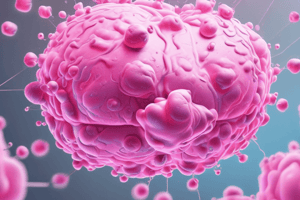Podcast
Questions and Answers
What is the role of estrone in breast cancer metastasis?
What is the role of estrone in breast cancer metastasis?
Estrone can enhance cancer cell proliferation and lead to increased breast cancer metastasis.
What is the function of SNAI2 in the context of cancer metastasis?
What is the function of SNAI2 in the context of cancer metastasis?
SNAI2 is involved in the epithelial-to-mesenchymal transition (EMT), a process crucial for cancer metastasis.
How does estrogen receptor alpha (ERa) contribute to breast cancer progression?
How does estrogen receptor alpha (ERa) contribute to breast cancer progression?
ERa presence in breast cancer cells makes them more susceptible to estrogen's effects, leading to increased proliferation and survival of cancer cells.
How does estrone level change in women during menopause?
How does estrone level change in women during menopause?
Explain the significance of epithelial-to-mesenchymal transition (EMT) in ER+ breast cancer metastasis.
Explain the significance of epithelial-to-mesenchymal transition (EMT) in ER+ breast cancer metastasis.
Explain the role of EMT in cancer metastasis.
Explain the role of EMT in cancer metastasis.
How does estrogen affect ER+ breast cancer cells?
How does estrogen affect ER+ breast cancer cells?
What is the significance of SNAI2 in the context of estrogen-dependent breast cancer metastasis?
What is the significance of SNAI2 in the context of estrogen-dependent breast cancer metastasis?
How does ERa contribute to activating signaling cascades in breast cancer cells?
How does ERa contribute to activating signaling cascades in breast cancer cells?
What are the implications of estrone in the development and spread of ER+ breast cancer?
What are the implications of estrone in the development and spread of ER+ breast cancer?
Flashcards are hidden until you start studying
Study Notes
Estrogens and Breast Cancer Metastasis
Breast cancer is one of the most common types of cancer worldwide, affecting millions of women globally. When it spreads beyond the initial site to other parts of the body, it's referred to as metastatic breast cancer. One of the main factors contributing to this progression is estrogen, specifically its role in promoting the growth and survival of certain types of breast cancer cells.
Estrone
Estrone (E1) is a type of estrogen hormone secreted by both men and women. In women, estrone levels increase during menopause when ovarian production decreases. It has been shown that high concentrations of estrone can enhance cancer cell proliferation and lead to increased breast cancer metastasis.
ERa
Estrogen receptor alpha (ERa) is a protein found in cells that binds to estrogen. This binding activates a signaling cascade that, among other functions, promotes cell proliferation. In breast cancer cells, the presence of ERa makes them more susceptible to estrogen's effects, which can lead to increased proliferation and survival of cancer cells.
SNAI2
SNAI2, also known as slug, is a transcription factor involved in the epithelial-to-mesenchymal transition (EMT), a process that plays a crucial role in cancer metastasis. EMT is a critical step in the metastasis of ER-positive (ER+) breast cancer. This process involves the reorganization of cells, allowing them to detach from their original site and migrate to other parts of the body.
Epithelial-to-mesenchymal transition
Epithelial-to-mesenchymal transition (EMT) is a biological process where epithelial cells lose their cell-cell adhesion and cell polarity, transforming into mesenchymal cells. This process is essential for embryonic development but can also promote tissue fibrosis and contribute to several pathologies, including cancer metastasis. EMT allows cancer cells to escape from their original location and invade surrounding tissues, leading to metastasis.
ER+ breast cancer metastasis
ER+ breast cancer cells have receptors for estrogen, which makes them particularly susceptible to estrogenic stimulation. This increased proliferation and survival of cancer cells can lead to an enhanced risk of metastasis, making it essential to understand the complex interplay between estrogen and its effects on these cells.
In conclusion, estrogen plays a significant role in the development and spread of breast cancer, especially in ER+ breast cancer cells. Understanding the mechanisms behind how estrogen promotes metastasis through processes like EMT, the involvement of transcription factors such as SNAI2, and the importance of ERa in activating signaling cascades will help researchers develop targeted therapeutic strategies to combat estrogen-dependent breast cancer metastasis.
Studying That Suits You
Use AI to generate personalized quizzes and flashcards to suit your learning preferences.




